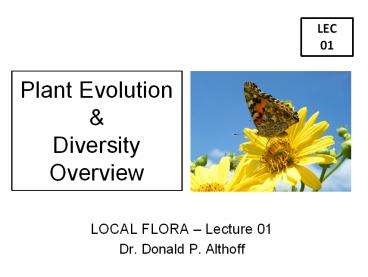Plant Evolution - PowerPoint PPT Presentation
1 / 29
Title:
Plant Evolution
Description:
LEC 01 Plant Evolution & Diversity Overview LOCAL FLORA Lecture 01 Dr. Donald P. Althoff SEEDS & FRUITS (not _____) ANGIOSPERMS Algae-to-Plants: Land Conquered ... – PowerPoint PPT presentation
Number of Views:294
Avg rating:3.0/5.0
Title: Plant Evolution
1
Plant Evolution Diversity Overview
LEC 01
- LOCAL FLORA Lecture 01
- Dr. Donald P. Althoff
2
(No Transcript)
3
(No Transcript)
4
ANGIOSPERMS
SEEDS FRUITS (not ___________)
5
Algae-to-Plants Land Conquered
- _______ or rootlike structures
- Conducting _________
- Stiffening substance __________
- Waxy ___________
- Pores called ____________
6
Flowering plants
mosses
ferns
conifers
________
______
_____________
_______________
protista
Algaeplant-like _________ organisms
7
Reproduction on land key
- Needed to have new method to transport sperm to
eggs - Accomplished by having sex cells carried by
_____or ____or ________ - And, _______ of developing embryos from
__________...
8
Evolutionary processcont
- First, ________
- Followed by _______
- Then, in the most advanced plants,
________________
9
ALTERNATING GENERATIONS Gametophyte (n)
produces gametes Sporophyte (2n) production of
spores by meiosis
10
Think 4 Major Divisions
- Bryophyta
- Pteridophyta
- Coniferophyta
- Anthrophyta
11
Division BryophytesLIVERWORTS MOSSES
- 16,000 species
- _____ true roots, leaves stems
- root equivalent -- RHIZOIDS
- ____________ plants
- rely on diffusion or poorly developed conducting
tissues to distribute water nutrients
NON-vascular plants
12
LIVERWORTS MOSSEScont
- most are _______ (2cm) max height
- main adaptation to land _____________
REPRODUCTIVE STRUCTURES archegonia
(egg develops) antheridia (sperm formed)
13
LIVERWORTS MOSSEScont
- sperm must swim to egg through a ____ ___________
- egg emits a _______________ to aid in location by
the sperm - timing of reproduction MUST coincide with
_________________this is very __________ in dry
environments
14
VASCULAR PLANTS (3 MAJOR CATEGORIES)
- Seedless Club mosses, horsetails,
ferns - Seed-bearing Conifers (pines) flowering
plants
vascular plants
15
Vascular, ___________ bearing plantsFERNS CLUB
MOSSES
- PTERIDOPHYTAferns most successful (12,00
0 species) - LYCOPHYTA--club mosses (ground
pine) (1,000 species) - SPENOPHYTA--horsetails (15 species)
16
FERNS CLUB MOSSEScont
- Distribution and dominance-wise, these plant
divisions _____ seen better days - Life cycles, again, tied to moist
conditions ex dominant plant body for
ferns is the sporophyte (frond)
17
Non-flowering, seed bearing plants Plants PINES,
GINKGOS, CYCADS
- Pines (500 species) (Conifers)
- Ginkgos (1 species Ginkgo biloba can you
remember this one?) -- male female
trees -- extinct in wild -- resistant to
air pollution - Cycads (160 species)
18
Conifers EVERGREENS(Division Coniferophyta)
- Gymnosperm ____________ in Latin
- Pines, spruces, firs, hemlocks, cypresses
- Once more ______________ and dominant on land
- Most are extremely well-adapted to _____(cold),
____ conditions.
19
Coniferscont
- Dry cold environment adaptations a) thin
needles with ______ cuticle b) _____
contains antifreeze (what gives it a
piney fragrance) - How do these adaptations help????
20
Conifersreproductive cycle
- Dominant form _____ diploid sporophyte
- Male female cones
- Pollen (from male cones) dispersed by wind
- Pollen landing on scale of female cone produces
pollen tube that burrows into female gametophyte
21
Flowering Seed Plants ANGIOSPERMS
- Division ANTHROPHYTA (anthro is Greek for
_______) - Angiosperm is Greek for ________
___________________ .angiosperms produce their
seeds enclosed within a fruit - Diverse group.corn, oaks, water lilies, cacti,
and buttercups
22
Angiospermscont
- 230,000 species
- the ________ plant division for over 100
million years - 3 major adaptations a) flowers
b) fruits c) broad leaves
1
2
3
23
Flowers
1
- Produced by sporophyte
- Males females generally in same flower
- _______ formed in anther (male)
- _______ formed in ovary (female)
- Fertilization accomplished with pollen tube
through the stigma
24
All in!
25
Fruit
2
- Contains the ovary which contains a
______________ - This adaptation greatly enhanced __________.most
seeds pass through digestive tracts of animals
unharmed. Some attached to fur.
26
Seeds
- Important source of food for humans.including
prehistoric times a) easy storage (if
kept dry) b) source of protein, oils,
carbohydrates, vitamins same goes for
germinating seed
27
Broad Leaves
3
- During favorable conditionsparticularly in
tropical and temperate zones_____ ______________
available to collect sunlight for photosynthesis.
- Excess production allows for storageand
subsequent dormant period
28
Broad Leavesliabilities
- Broad, ________ leaves are more appealing to
herbivores than conifer leaves (needles) - To __________.some have developed
defenses a) thorns, spines,
resins b) chemical compounds that may be
toxic or distasteful
29
Flowering plants
mosses
ferns
conifers
Flowers
Seeds
Vascular tissue
All multicelluar
protista
Algaeplant-like single-cell organisms

